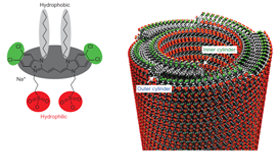Design of Self-Assembling Light-Harvesting Nanotubes
Molecular self-assembly is widely recognized as a promising route to form nanoscale functional materials. Nature yields inspiration for highly successful self-assembled structures, in particular in the light-harvesting systems that occur in photosynthetic bacteria and plants. In these systems, the overall morphology of the assembly and its molecular packing is such that internal quantum efficiencies of 95% are reached Understanding the success of natural systems is an important step towards the design of artificial light-harvesting systems and, more generally, efficient molecular energy transport systems.
Excellent model systems to explore the relevant questions are molecular aggregates consisting of dye molecules that self-assemble in solution via π-stacking, Van der Waals interactions, and hydrophobicity/-philicity. Tubular aggregates are particularly interesting because they combine the wire-like structure with robustness against disorder through the second (rolling) dimension. Various examples of such tubular aggregates have been created during the past decade, all of them typically with diameters of about 10 nm and lengths of 100’s of nm to microns, thus constituting real nanosystems. Tubular aggregates also occur in nature as chlorosomes in Green Sulphur bacteria, one of the most efficient light-harvesting complexes known. While recently an increased interest in self-assembled tubular aggregates has occurred, detailed studies and understanding of excitation energy transport generally are lacking, which finds its origin in both experimental and theoretical challenges that we address in our center.

Combining the expertise of the Molecular Dynamics and Theory of Condensed Matter groups, together with the experimental expertise of the Optical Condensed Matter group, the current focus is on aggregates that form in solutions of the dye C8S3. Cryo-EM reveals a hierarchy of self-assembled structures including double-walled nanotubes; under certain conditions, bundles of nanotubes arise. Thus, this system allows for the occurrence of electronic excitation energy transport at various levels: within one wall, between walls of one tube, and between different tubes. Key questions are: is the transport coherent or incoherent? Can we control the degree of coherence, e.g. with temperature? What is the typical spatial extent of the transport?
Key publications:
- Bloemsma, E. A., Vlaming, S. M., Malyshev, V. A., & Knoester, J. (2015). Signature of Anomalous Exciton Localization in the Optical Response of Self-Assembled Organic Nanotubes. Physical Review Letters, 114(15), [156804]. 10.1103/PhysRevLett.114.156804
- Haverkort, F., Stradomska, A., Vries, A. H. D., & Knoester, J. (2014). First-Principles Calculation of the Optical Properties of an Amphiphilic Cyanine Dye Aggregate. The Journal of Physical Chemistry. A: Molecules, Spectroscopy, Kinetics, Environment, & General Theory, 118(6), 1012-1023. 10.1021/jp4112487
